Mitsubishi MXZ-8C160VAMD Handleiding
Mitsubishi
Airco
MXZ-8C160VAMD
Bekijk gratis de handleiding van Mitsubishi MXZ-8C160VAMD (21 pagina’s), behorend tot de categorie Airco. Deze gids werd als nuttig beoordeeld door 43 mensen en kreeg gemiddeld 3.8 sterren uit 22 reviews. Heb je een vraag over Mitsubishi MXZ-8C160VAMD of wil je andere gebruikers van dit product iets vragen? Stel een vraag
Pagina 1/21

INSTALLATION MANUAL
For safe and correct use, please read this installation manual thoroughly before installing the air-conditioner unit. English
Air-Conditioners OUTDOOR UNIT
MXZ-8C140/160VAMD-A
EnglishEnglish
HFC
utilized
R410A
FOR INSTALLER

2
Contents
1. Safety precautions
► Before installing the unit, make sure you read all the “Safety precautions”.
► Please report to or take consent by the supply authority before connec-
tion to the system.
After installation work has been completed, explain the “Safety Precautions” use,
and maintenance of the unit to the customer according to the information in the
Operation Manual and perform the test run to ensure normal operation. Both the
Installation Manual and Operation Manual must be given to the user for keeping.
These manuals must be passed on to subsequent users.
: Indicates a part which must be grounded.
Warning:
Carefully read the labels afxed to the main unit.
Warning:
• The unit must not be installed by the user. Ask a dealer or an authorized
technician to install the unit. If the unit is installed incorrectly, water leakage,
electric shock, or re may result.
• For installation work, follow the instructions in the Installation Manual and use
tools and pipe components specically made for use with R410A refrigerant.
• The R410A refrigerant in the HFC system is pressurized 1.6 times the pres-
sure of usual refrigerants. If pipe components not designed for R410A refrig-
erant are used and the unit is not installed correctly, the pipes may burst and
cause damage or injuries. In addition, water leakage, electric shock, or re
may result.
• The unit must be installed according to the instructions in order to minimize
the risk of damage from earthquakes, typhoons, or strong winds. An incor-
rectly installed unit may fall down and cause damage or injuries.
•
The unit must be securely installed on a structure that can sustain its weight.
If the unit is mounted on an unstable structure, it may fall down and cause
damage or injuries.
•
If the air conditioner is installed in a small room, measures must be taken to
prevent the refrigerant concentration in the room from exceeding the safety limit
in the event of refrigerant leakage. Consult a dealer regarding the appropriate
measures to prevent the allowable concentration from being exceeded.
Should the refrigerant leak and cause the concentration limit to be exceeded,
hazards due to lack of oxygen in the room may result.
• Ventilate the room if refrigerant leaks during operation. If refrigerant comes
into contact with a ame, poisonous gases will be released.
• All electric work must be performed by a qualied technician according to
local regulations and the instructions given in this manual. The units must
be powered by dedicated power lines and the correct voltage and circuit
breakers must be used. Power lines with insufcient capacity or incorrect
electrical work may result in electric shock or re.
• Be sure to connect the power supply cords and the connecting wires for
the indoor units, outdoor units, and branch boxes directly to the units (no
intermediate connections).
Intermediate connections can lead to communication errors if water enters
the cords or wires and causes insufcient insulation to ground or a poor
electrical contact at the intermediate connection point.
(If an intermediate connection is necessary, be sure to take measures to
prevent water from entering the cords and wires.)
• Use C1220 copper phosphorus, for copper and copper alloy seamless pipes,
to connect the refrigerant pipes. If the pipes are not connected correctly, the
unit will not be properly grounded and electric shock may result.
• Use only specied cables for wiring. The wiring connections must be made
securely with no tension applied on the terminal connections. Also, never
splice the cables for wiring (unless otherwise indicated in this document).
Failure to observe these instructions may result in overheating or a re.
• The terminal block cover panel of the outdoor unit must be rmly attached. If
the cover panel is mounted incorrectly and dust and moisture enter the unit,
electric shock or re may result.
• When installing or relocating, or servicing the outdoor unit, use only the
specied refrigerant (R410A) to change the refrigerant lines. Do not mix it
with any other refrigerant and do not allow air to remain in the lines.
If air is mixed with the refrigerant, then it can be the cause of abnormal high pres-
sure in the refrigerant line, and may result in an explosion and other hazards.
The use of any refrigerant other than that specied for the system will cause
mechanical failure or system malfunction or unit breakdown. In the worst
case, this could lead to a serious impediment to securing product safety.
• Use only accessories authorized by Mitsubishi Electric and ask a dealer
or an authorized technician to install them. If accessories are incorrectly
installed, water leakage, electric shock, or re may result.
• Do not alter the unit. Consult a dealer for repairs. If alterations or repairs are
not performed correctly, water leakage, electric shock, or re may result.
•
The user should never attempt to repair the unit or transfer it to another location.
If the unit is installed incorrectly, water leakage, electric shock, or re may
result. If the air conditioner must be repaired or moved, ask a dealer or an
authorized technician.
• After installation has been completed, check for refrigerant leaks. If refriger-
ant leaks into the room and comes into contact with the ame of a heater or
portable cooking range, poisonous gases will be released.
1.1. Before installation
Caution:
• Do not use the unit in an unusual environment. If the air conditioner is
installed in areas exposed to steam, volatile oil (including machine oil), or
sulfuric gas, areas exposed to high salt content such as the seaside, or areas
where the unit will be covered by snow, the performance can be signicantly
reduced and the internal parts can be damaged.
• Do not install the unit where combustible gases may leak, be produced,
ow, or accumulate. If combustible gas accumulates around the unit, re or
explosion may result.
Warning:
Describes precautions that must be observed to prevent danger of injury or
death to the user.
Caution:
Describes precautions that must be observed to prevent damage to the unit.
• The outdoor unit produces condensation during the heating operation. Make
sure to provide drainage around the outdoor unit if such condensation is
likely to cause damage.
• When installing the unit in a hospital or communications ofce, be prepared
for noise and electronic interference. Inverters, home appliances, high-
frequency medical equipment, and radio communications equipment can
cause the air conditioner to malfunction or breakdown. The air conditioner
may also affect medical equipment, disturbing medical care, and communi-
cations equipment, harming the screen display quality.
1.2. Before installation (relocation)
Caution:
• Be extremely careful when transporting the units. 2 or more persons are
needed to handle the unit, as it weighs 20 kg or more. Do not grasp the pack-
aging bands. Wear protective gloves to remove the unit from the packaging
and to move it, as you can injure your hands on the ns or the edge of other
parts.
• Be sure to safely dispose of the packaging materials. Packaging materials,
such as nails and other metal or wooden parts may cause stabs or other
injuries.
• The base and attachments of the outdoor unit must be periodically checked
for looseness, cracks or other damage. If such defects are left uncorrected,
the unit may fall down and cause damage or injuries.
• Do not clean the air conditioner unit with water. Electric shock may result.
• Tighten all are nuts to specication using a torque wrench. If tightened too
much, the are nut can break after an extended period and refrigerant can
leak out.
Conrmation of parts attached
In addition to this manual, the following parts are supplied with the outdoor unit.
They are used for grounding the S terminals of transmission terminal blocks TB3, TB7.
For details refer to “7. Electrical work”. Grounding lead wire ( 2)×
1. Safety precautions 2 . . . . . . . . . . . . . . . . . . . . . . . . . . . . . . . . . . . . . . . . . . . . . . . .
2. Installation diagram & parts 3 . . . . . . . . . . . . . . . . . . . . . . . . . . . . . . . . . . . . . . . . .
3. Installation location 4 . . . . . . . . . . . . . . . . . . . . . . . . . . . . . . . . . . . . . . . . . . . . . . .
4. Installing the outdoor unit 6 . . . . . . . . . . . . . . . . . . . . . . . . . . . . . . . . . . . . . . . . . .
5. Installing the refrigerant piping 6 . . . . . . . . . . . . . . . . . . . . . . . . . . . . . . . . . . . . . .
6. Drainage piping work 10 . . . . . . . . . . . . . . . . . . . . . . . . . . . . . . . . . . . . . . . . . . . . .
7. Electrical work 10 . . . . . . . . . . . . . . . . . . . . . . . . . . . . . . . . . . . . . . . . . . . . . . . . . .
8. Test run 17 . . . . . . . . . . . . . . . . . . . . . . . . . . . . . . . . . . . . . . . . . . . . . . . . . . . . . . .
9. Special Functions 18 . . . . . . . . . . . . . . . . . . . . . . . . . . . . . . . . . . . . . . . . . . . . . . .

3
2.1. Before installation (Fig. 2-1)
This installation manual is only for the outdoor unit installation. In installing
the indoor units and branch box, refer to the installation manual attached
to each unit.
Any structural alterations necessary for the installation must comply with the local
building code requirements.
This diagram is intended to show the conguration of accessories.
For actual installation, the outdoor unit is to be turned 180°.
Units should be installed by licensed contractor according to local code requirement.
Note:
The dimensions given along the arrows above are required to guarantee the
air conditioner’s performance. Install the unit in as wide a place as possible
for later service or repairs.
Parts to be locally procured
Branch box/outdoor unit connecting wire (3-core) 1
Extension pipe 1
Wall hole sleeve 1
Wall hole cover 1
Pipe xing band
(The quantity depends on the pipe length.) 2 to 7
Fixing screw for 4 × 20 mm
(The quantity depends on the pipe length.) 2 to 7
Piping tape 1
Putty 1
Refrigeration oil 1
Power supply cord (2-core, Refer to 7.3. Wiring transmission cables) 1
1.3. Before electric work
Caution:
• Be sure to install circuit breakers. If not installed, electric shock may result.
IMPORTANT
Make sure that the current leakage breaker is one compatible with higher
harmonics.
Always use a current leakage breaker that is compatible with higher har-
monics as this unit is equipped with an inverter.
The use of an inadequate breaker can cause the incorrect operation of in-
verter.
• For the power lines, use standard cables of sufcient capacity. Otherwise, a
short circuit, overheating, or re may result.
• When installing the power lines, do not apply tension to the cables. If the
connections are loosened, the cables can snap or break and overheating or
re may result.
• Be sure to ground the unit. Do not connect the ground wire to gas or water
pipes, lighting rods, or telephone grounding lines. If the unit is not properly
grounded, electric shock may result.
• Use circuit breakers (ground fault interrupter, isolating switch (+B fuse), and
molded case circuit breaker) with the specied capacity. If the circuit breaker
capacity is larger than the specied capacity, breakdown or re may result.
1.4. Before starting the test run
Caution:
•
Turn on the main power switch more than 12 hours before starting operation.
Starting operation just after turning on the power switch can severely dam-
age the internal parts. Keep the main power switch turned on during the
operation season.
• Before starting operation, check that all panels, guards and other protective
parts are correctly installed. Rotating, hot, or high voltage parts can cause
injuries.
• Do not touch any switch with wet hands. Electric shock may result.
• Do not touch the refrigerant pipes with bare hands during operation. The
refrigerant pipes are hot or cold depending on the condition of the owing
refrigerant. If you touch the pipes, burns or frostbite may result.
• After stopping operation, be sure to wait at least 5 minutes before turning off
the main power switch. Otherwise, water leakage or breakdown may result.
1.5. Using R410A refrigerant air conditioners
Caution
• Use C1220 copper phosphorus, for copper and copper alloy seamless pipes,
to connect the refrigerant pipes. Make sure the insides of the pipes are clean
and do not contain any harmful contaminants such as sulfuric compounds,
oxidants, debris, or dust. Use pipes with the specied thickness. (Refer to
page 6) Note the following if reusing existing pipes that carried R22 refriger-
ant.
- Replace the existing are nuts and are the ared sections again.
- Do not use thin pipes. (Refer to page 6)
• Store the pipes to be used during installation indoors and keep both ends of
the pipes sealed until just before brazing. (Leave elbow joints, etc. in their
packaging.) If dust, debris, or moisture enters the refrigerant lines, oil dete-
rioration or compressor breakdown may result.
• Use ester oil, ether oil, alkylbenzene oil (small amount) as the refrigeration
oil applied to the ared sections. If mineral oil is mixed in the refrigeration
oil, oil deterioration may result.
• Do not use refrigerant other than R410A refrigerant. If another refrigerant is
used, the chlorine will cause the oil to deteriorate.
• Use the following tools specically designed for use with R410A refrigerant.
The following tools are necessary to use R410A refrigerant. Contact your
nearest dealer for any questions.
Tools (for R410A)
Gauge manifold Flare tool
Charge hose Size adjustment gauge
Gas leak detector Vacuum pump adapter
Torque wrench Electronic refrigerant charging scale
• Be sure to use the correct tools. If dust, debris, or moisture enters the refrig-
erant lines, refrigeration oil deterioration may result.
• Do not use a charging cylinder. If a charging cylinder is used, the composi-
tion of the refrigerant will change and the efciency will be lowered.
1. Safety precautions
2. Installation diagram & parts
Fig. 2-1
Outdoor unit
Branch box
5-branches type
3-branches type
Product specificaties
| Merk: | Mitsubishi |
| Categorie: | Airco |
| Model: | MXZ-8C160VAMD |
Heb je hulp nodig?
Als je hulp nodig hebt met Mitsubishi MXZ-8C160VAMD stel dan hieronder een vraag en andere gebruikers zullen je antwoorden
Handleiding Airco Mitsubishi
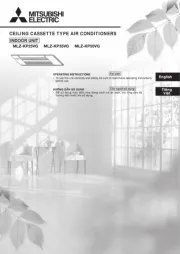
7 Mei 2025
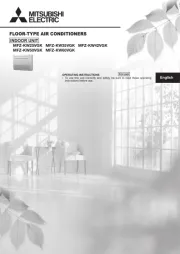
7 Mei 2025
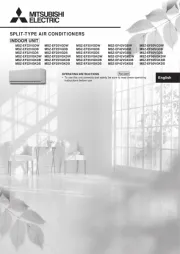
7 Mei 2025
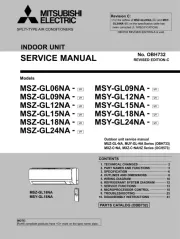
31 Maart 2025
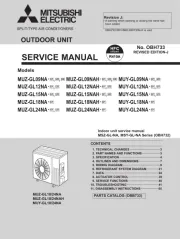
31 Maart 2025
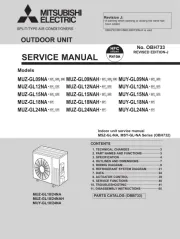
31 Maart 2025
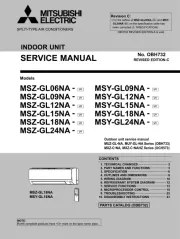
31 Maart 2025

30 Maart 2025

27 Maart 2025

27 Maart 2025
Handleiding Airco
- Vestel
- Defy
- Thermex
- Termozeta
- REMKO
- Remeha
- Bestron
- Eden
- Convair
- Airwell
- Braemar
- Nedis
- Telefunken
- Columbia Vac
- Ardes
Nieuwste handleidingen voor Airco
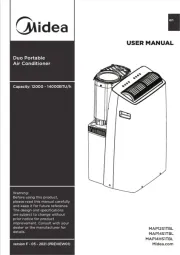
2 Augustus 2025
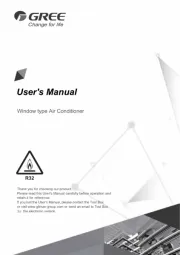
30 Juli 2025
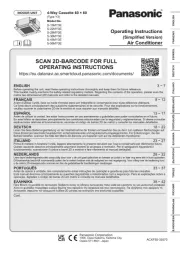
30 Juli 2025
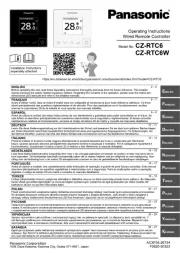
30 Juli 2025
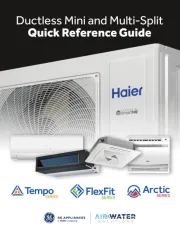
30 Juli 2025
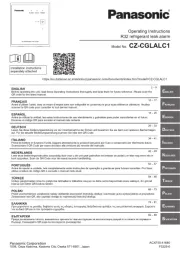
30 Juli 2025
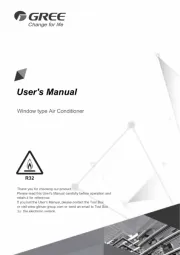
29 Juli 2025
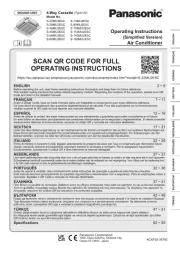
29 Juli 2025
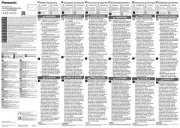
29 Juli 2025
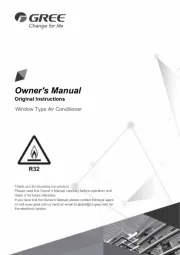
29 Juli 2025